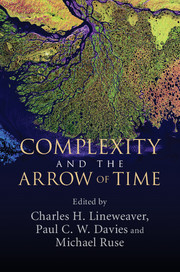Book contents
- Frontmatter
- Contents
- Author biographies
- Part I Introduction
- Part II Cosmological and physical perspectives
- 2 Directionality principles from cancer to cosmology
- 3 A simple treatment of complexity: cosmological entropic boundary conditions on increasing complexity
- 4 Using complexity science to search for unity in the natural sciences
- 5 On the spontaneous generation of complexity in the universe
- 6 Emergent spatiotemporal complexity in field theory
- Part III Biological complexity, evolution, and information
- Part IV Philosophical perspectives
- Index
- References
6 - Emergent spatiotemporal complexity in field theory
from Part II - Cosmological and physical perspectives
Published online by Cambridge University Press: 05 July 2013
- Frontmatter
- Contents
- Author biographies
- Part I Introduction
- Part II Cosmological and physical perspectives
- 2 Directionality principles from cancer to cosmology
- 3 A simple treatment of complexity: cosmological entropic boundary conditions on increasing complexity
- 4 Using complexity science to search for unity in the natural sciences
- 5 On the spontaneous generation of complexity in the universe
- 6 Emergent spatiotemporal complexity in field theory
- Part III Biological complexity, evolution, and information
- Part IV Philosophical perspectives
- Index
- References
Summary
The origin of spatiotemporal order in physical and biological systems is a key scientific question of our time. How does microscopic matter self-organize to create living and non-living macroscopic structures? Do systems capable of generating spatiotemporal complexity obey certain universal principles? We propose that progress along these questions may be made by searching for fundamental properties of non-linear field models which are common to several areas of physics, from elementary particle physics to condensed matter and biological physics. In particular, we've begun exploring what models that support localized coherent (soliton-like) solutions – both time-dependent and time-independent – can tell us about the emergence of spatiotemporal order. Of interest to us is the non-equilibrium dynamics of such systems and how it differs when they are allowed to interact with external environments. It is argued that the emergence of spatiotemporal order delays energy equipartition and that growing complexity correlates with growing departure from equipartition. We further argue that the emergence of complexity is related to the existence of attractors in field configuration space and propose a new entropic measure to quantify the degree of ordering of localized energy configurations.
SOLITONS AND SELF-ORGANIZATION
A key question across the natural sciences is how simple material entities self-organize to create coherent structures capable of complex behavior. As an example, phenomena as diverse as water waves and symmetry-breaking during phase transitions can give rise to solitons, topologically or non-topologically stable spatially-localized structures (“energy lumps”) that keep their profiles as they move across space. They beautifully illustrate cooperative behavior in Nature, that is, how interacting discrete entities work in tandem to generate complex structures that minimize energy and other physical quantities (Infeld & Rowlands, 2000; Walgraef, 1997; Cross & Hohenberg, 1993; Rajamaran, 1987; Lee & Pang, 1992).
- Type
- Chapter
- Information
- Complexity and the Arrow of Time , pp. 113 - 132Publisher: Cambridge University PressPrint publication year: 2013
References
- 2
- Cited by



